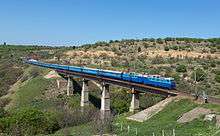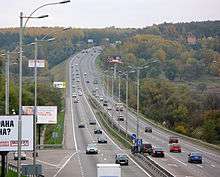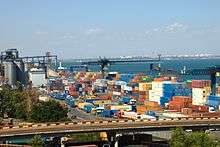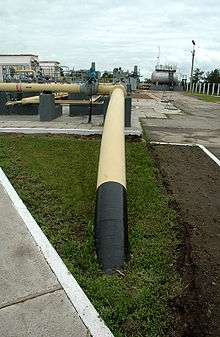Transport in Ukraine
Transport in Ukraine includes ground transportation (road and rail), water (sea and river), air transportation, and pipelines. The transportation sector accounts for roughly 11% of the country's gross domestic product and 7% of total employment.
Economy
Transport Infrastructure
Today the transport sector in Ukraine generally meets only the basic needs of the economy and population. The level of safety, quality and efficiency of passenger and freight transport, as well as the infrastructure's amount of energy usage, and the technological burden it places on the environment do not meet modern-day requirements.
Due to the low level of demand, the country's existing transit potential and advantageous geographical position is not fully utilised. There is thus a lag in the development of transport infrastructure, transport and logistics technologies and multimodal transport. All this has made Ukraine uncompetitive as the high costs of transport across the country make the cost of production in the country uncommonly high.
International Transport Corridors
The advantageous geographical position of Ukraine allows for the location of a number of International Transport Corridors on its territory, in particular :
- Pan-European transport corridors № 3, 5, 7, 9;
- Rail Co-Operation Corridors (ORC) № 3, 4, 5, 7, 8, 10 and
- European Transport Corridors - Caucasus - Asia (TRACECA) and Europe - Asia.
Transport Industry
The share of the transport sector in Ukraine's gross domestic product (according to Goskomstat) as of 2009 was 11.3%. The number of workers employed in the sector is almost 7% of total employment. The transportation infrastructure of Ukraine is adequately developed overall, however it is obsolete and in need of major modernization. A remarkable boost in the recent development of the country's transportation infrastructure was noticed after winning the right to host a major continental sport event the UEFA Euro 2012.
In 2009, Ukrainian infrastructure provided for the transportation of 1.5 billion tons of cargo and 7.3 billion passengers. As the global financial crisis took hold and demand for major export commodities in 2009 fell, the volume of freight traffic decreased by 17,6% when compared with figures from 2008; passenger transport fell by 12,7%.
Freight and Passenger Transportation Statistics[1]
| Transported tons of freights | Freight kilometres (thousand) | Transported passengers (thousand) | Passenger kilometres (thousand) | |
|---|---|---|---|---|
| 2000 | 938 916,1 | 19 281 619,3 | 2603 804,6 | 29 381 541.2 |
| 2002 | 947 263,8 | 20 593 133,1 | 3069 136,3 | 35 812 231.1 |
| 2004 | 1027 396,3 | 28 847 143,4 | 3720 326,4 | 47 490 401.3 |
| 2006 | 1167 199,6 | 40 566 469,9 | 3987 982,2 | 53 981 705.3 |
| 2008 | 1266 598,1 | 54 877 223,3 | 4369 125,5 | 61 302 884.5 |
Rail

The public railways in Ukraine are managed by the state railway company Ukrzaliznytsia[2]
Network length (2010)
The length of the railway network Ukraine ranks third in Europe (21.7000 kilometres of track).
- 22,000 km (13,670 mi) broad gauge of 1,520 mm (4 ft 11 27⁄32 in), ~10,000 km (6,214 mi) electrified (3 kV DC and 25 kV AC)
- 201 km (125 mi) of 1,435 mm (4 ft 8 1⁄2 in) standard gauge, electrified
Rail links with adjacent countries
- Belarus
- Russia
- Moldova
- Romania (break-of-gauge: 1,520 mm (4 ft 11 27⁄32 in) / 1,435 mm (4 ft 8 1⁄2 in))
- Hungary (break-of-gauge: 1,520 mm (4 ft 11 27⁄32 in) / 1,435 mm (4 ft 8 1⁄2 in))
- Slovakia (break-of-gauge: 1,520 mm (4 ft 11 27⁄32 in) / 1,435 mm (4 ft 8 1⁄2 in))
- Poland (break-of-gauge: 1,520 mm (4 ft 11 27⁄32 in) / 1,435 mm (4 ft 8 1⁄2 in) plus a standard gauge cross-border cargo line)
Rolling stock and service
Ukrainian trains and trackway are incapable of speeds more than 160 kilometres per hour. However, the number of railway passengers and freight climbs. The government made huge investments in the railways in preparation for Euro 2012. There are intercity trains between Euro 2012 cities (Kiev, Lviv, Kharkiv and Donetsk). However, there is currently not enough line capacity provided on routes to the south and the Crimea.
Maps
Roads and Auto


The development of public roads in Ukraine is currently lagging behind the pace of motorisation in the country. During 1990-2010 the length of the highways network hardly increased at all. The density of highways in Ukraine is 6.6 times lower than in France (respectively 0.28 and 1.84 kilometres of roads per square kilometre area of the country). The length of express roads in Ukraine is 0.28 thousand km (in Germany - 12.5 thousand kilometres in France - 7.1 thousand kilometres), and the level of funding for each kilometre of road in Ukraine is around 5,5 - 6 times less than in those locations.
This is due to a number of objective reasons, including that the burden of maintaining the transport network per capita is significantly higher than in European countries because of Ukraine's relatively low population density (76 people per square kilometre), low purchasing power of citizens (1/5 of the Eurozone's purchasing capacity), relatively low car ownership and the nation's large territory.
The operational condition of roads is very poor; around 51.1% of roads do not meet minimum standards, and 39.2% require major rebuilds. The average speed on roads in Ukraine 2 - 3 times lower than in Western countries. As of 2016, many of Ukraine's major provincial highways are in very poor condition, with an Ukravtodor official stating that 97% of roads are in need of repair. The road repair budget was set at about 20 billion hryvnias, but corruption causes the budget to be poorly spent and overweight trucks are common place rapidly causing more road damage.[5]
- Total: 169,477 km
- Paved: 164,732 km (102,360 mi) (including 15 km (9 mi) of expressways); note - these roads, classified as "hard-surfaced", include both hard-paved highways and some all-weather gravel-surfaced roads.
- Unpaved: 4,745 km (2,948 mi) (2004)
Principal roads
Motorways in Ukraine, 193 km (120 mi) (2010):
Kiev - Boryspil | Kharkiv - Dnipro
State Highways, 8,080 km (5,020 mi) (2009):
M01 | M02 | M03 | M04 | M05 | M06 | M07 | M08 | M09 | M10 | M11 | M12 | M13 | M14 | M15 | M16 | M17 | M18 | M19 | M20 | M21 | M22 | M23
Note: State highways are important national routes and are not necessarily high-speed roads
Aviation

Outlook
The aviation section in Ukraine is developing very quickly, having recently established a visa-free program for EU nationals and citizens of a number of other 'Western' nations,[6] the nation's aviation sector is handling a significantly increased number of travellers. Additionally, the granting of the Euro 2012 football tournament to Poland and Ukraine as joint hosts has prompted the government to invest huge amounts of money into transport infrastructure, and in particular airports.[7]
Currently there are three major new airport terminals under construction in Donetsk, Lviv and Kiev, a new terminal has already opened in Kharkiv and Kiev's Boryspil International Airport has recently begun operations at Terminal F,[8] the first of its two new international terminals. Ukraine has a number of airlines, the largest of which are the nation's flag carriers, Aerosvit and UIA. Antonov Airlines, a subsidiary of the Antonov Aerospace Design Bureau is the only operator of the world's largest fixed wing aircraft, the An-225.
Donetsk Airport destroyed due to War in Donbass.
New terminal at Odessa International Airport has been opened for arrival flights on April 14, 2017.[9]
Airports
- Total: 412 (2012)
Airports with paved runways
- Total: 179
- Over 3,047 m: 13
- 2,438 to 3,047 m: 49
- 1,524 to 2,437 m: 22
- 914 to 1,523 m: 6
- Under 914 m: 89 (2012)
Major airports are: Kiev Boryspil Airport, Dnipropetrovsk Airport, Kharkiv Airport, Lviv Airport, Donetsk Airport, Odessa Airport, and Simferopol Airport.
Airports with unpaved runways
- Total: 233
- 2,438 to 3,047 m: 2
- 1,524 to 2,437 m: 6
- 914 to 1,523 m: 9
- Under 914 m: 216 (2012)
Heliports
- Total: 7 (2012)
Water transport

River transport
1,672 km (1,039 mi) navigable waterways on 7 rivers, most of them are on Danube, Dnieper and Pripyat rivers. All Ukraine's rivers freeze over in winter (usually December through March), limiting navigation. However, river icebreakers are available on the Dnieper, at least in vicinity of Kiev.[10]
Danube
The most important waterway of Ukraine.
Dnipro
Dnipro within Ukraine is a regulated system of reservoirs separated by dams with shiplocks. The river is navigable through all its Ukrainian length.
Pripyat
Notable riverport Chernobyl is now abandoned due to the Chernobyl disaster, but the waterway retains its importance as part of the Dnieper–Baltic Sea route.
Southern Bug
Plans are announced to revitalize commercial freight navigation on the Southern Bug as part of the increasing grain export from Ukraine.[11]
Sea transport
Merchant marine
- Total: 134 ships (1,000 gross register tons (GRT) or over) totaling 862,690 GRT/963,550 tonnes deadweight (DWT)
- Ships by type: bulk carrier 3, cargo ship 98, chemical tanker 1, passenger ship 6, passenger/cargo ship 5, petroleum tanker 8, refrigerated cargo ship 11, specialized tanker 2 (2010)
Sea ports and harbours

As of July 2013, Ukraine had 18 "marine trade ports" available for foreign ships' entry.[12] Some of these "marine trade ports" are actually port conglomerates comprising several non-adjacent ports and tenant private terminals. Major river ports are also considered "marine" international ports.
- Berdyansk (Sea of Azov)
- Agro-CLASS (oil terminal)
- Bilhorod-Dnistrovsky Seaport (Black Sea)
- Port Buhaz (auxiliary)
- Theodosia (Black Sea)
- Chornomorsk (Black Sea)

- Aldi (specialized complex)
- Chornomorsk Fuel Terminal
- Chem-Oil-Transit-Ukraine
- Trans Bulk Terminal (grain complex)
- Ship Maintenance Factory
- Fishing port
- Izmail (Danube river / Black Sea)
- Triton Services Agency Ukraine (oil pier)
- Portoflot (specialized terminal)
- Kerch (Black Sea)
- Zaliv Shipbuilding yard
- Port Krym

- Fishing port
- Oil terminal of fishing port
- TES-Terminal
- Port Kamysh-Burun[13] (Azov Sea)
- Kherson (Dnipro river / Black Sea)
- Kherson Shipyard
- All-Ukrainian Industrial Union
- Palada
- Mariupol (Sea of Azov)
- Metallurgy Complex Azovstal
- Ship Maintenance Factory
- Freight terminal of ship maintenance factory
- Mykolayiv (Southern Bug river / Black Sea)
- Freight terminal of Nika-Terra
- Freight terminal of Okean
- Freight terminal of Black Sea Shipyard
- Freight terminal of Mykolaiv Alumina Factory
- Freight terminal of Nibulon
- Freight terminal of Greentour-ex
- Port of Mykolaiv Grain Elevator (grain terminal)
- Port Ochakiv
- Dnipro-Buh Sea Terminal
- Olvia (in Mykolayiv, Southern Bug river / Black Sea), a "specialized" weapons-transiting port[14][15]
- Port of Odessa (Black Sea)
- Reni (Danube river / Black Sea)
- Port of Sevastopol (Black Sea)
- Port Balaklava (auxiliary)
- Skadovsk (Black Sea)
- Port Khorly (auxiliary)
- Port Henichesk (auxiliary)
- Ust-Dunaisk (Vylkove) (Danube river / Black Sea)
- Yalta (Black Sea)
- Yuzhny (Black Sea)
- Trans invest service
- Trans invest service (containers)
- Sea Side (Ukraine)
- UkrTransNafta (oil terminal)
- Borivage (grain terminal)
- Transbunker-Yuzhny
- Yevpatoria (Black Sea)
Other notable seaports
- Donuzlav (Black Sea)
- Chornomorske (Black Sea) - Ukraine's offshore drilling base port
Important supporting agencies
- Delta Lotsman, the maritime pilot company serving the territorial waters of Ukraine
- "Derzhhidrohrafiya" (State Hydro Geography),[16] a scientific-production complex of hydro-grographical state companies and science-research center "Ukrmorkartohrafiya" (all lighthouses located in Ukraine belong to the institution)[17] The Black Sea Fleet of the Russian Federation refuses to surrender former Soviet navigational facilities since 1997
- Maritime Security Agency[18] in correspondence of the SOLAS International Convention (including its amendment the ISPS Code)
- Shipping registry of Ukraine
- Port registry of Ukraine
Shipping companies
- UkrFerry
- Ukrrichflot
- Ukrainian Danube Shipping, freight and passenger transportation company (primarily Danube river delta)
- Black Sea Shipping Company, freight and passenger transportation company
Ship building and maintenance companies
- Ship building and maintenance companies of Ukraine[19]
Pipelines
- natural gas 36,493 km (22,676 mi) (2010)
- crude oil 4,514 km (2,805 mi) (2010)
- petroleum products 4,211 km (2,617 mi) (2010)
- ammonia
The natural gas transport-system can take in a maximum of 288 billion cubic meters of natural gas per year. Its annual output capacity is 178.5 billion cubic meters, including 142.2 billion to be forwarded to European countries.[20]

See also
References
- ↑ "2E +% C2% E0% ED% F2% E0% E6% ED% B3 +% F2% E0 +% EF% E0% F1% E0% E6% E8% F0% F1% FC% EA% B3 +% E0% E2% F2% EE% EF% E5% F0% E5% E2% E5% E7% E5% ED% ED% FF & path =.. / Database/Regiostat/13/01 / & lang = 1 Freight and passenger road transportation in Ukraine". stat.lviv.ua.
- ↑ Industrial railways and metros in cities are managed independently.
- ↑ Railway Gazette International April 2008 p 240
- ↑ "Railways through Europe".
- ↑ Dan Peleschuk (16 June 2016). "Ukraine's Broken Road to Europe". Foreign Policy. Retrieved 17 June 2016.
- ↑ "Consular Information".
- ↑ Patkevich, Kostyantyn; Sobko, Dmytro. "Kharkiv airport gets new terminal". Retrieved 11 Sep 2013.
- ↑ "Archived copy". Archived from the original on 2010-11-20. Retrieved 2010-11-12.
- ↑ "New terminal launched at Odesa airport - Russian aviation news". Russian Aviation Insider. 2017-04-19. Retrieved 2018-06-09.
- ↑ "Киевскую дамбу может разрушить только метеорит или война — Эксперт". www.segodnya.ua.
- ↑ «НИБУЛОН» заложил основу собственного флота(in Ukrainian)
- ↑ Уряд затвердив перелік українських морських портів, відкритих для заходження іноземних суден. Cabinet of Ministers of Ukraine (in Ukrainian). 06.07.2013. Retrieved 18 September 2013. Check date values in:
|date=(help) - ↑ "Порт «Камыш-Бурун»". www.altcom.ua.
- ↑ Warrick, Joby (8 September 2013). "Ukrainian port eyed as analysts seek Syria's arms source". Washington Post. Retrieved 9 September 2013.
- ↑ "Port of Oktyabrsk". World Port Source.
- ↑ "Парковая страница Imena.UA". www.hydrography.com.ua.
- ↑ "Єжель вимагає повернути Україні маяки в Криму". comments.ua.
- ↑ "Official website of the Maritime Security Agency". dp-amb.kiev.ua. Archived from the original on 2013-08-21.
- ↑ "Про затвердження переліку суднобудівних підприємств, для я... - від 21.12.2005 № 1256". zakon4.rada.gov.ua.
- ↑ Natural gas transit through Ukraine down 24.8% year on year, Kyiv Post (November 16, 2009)
External links
Unofficial databases
- Shipowners database, arranged by country ((in Russian))
- All lighthouses of Ukraine
- Informational-reference website "Ukraine"